☘️LIVE LIKE A LORD – 8 DAY SELF DRIVE CASTLES TOUR
Tour Categories: ☘️IRISH CASTLES/ELEGANT TOURS ☘️IRISH WHISKEY & FOOD TOURS ☘️SELF-DRIVE/PRIVATE TOURS
Duration: 8 Days/9 Nights.
Arrive/Depart: Dublin Airport.
Dates: ☘️February - December 2025 - 2026☘️
Price: FROM $4,295
LIVING LIKE A LORD IN IRELAND
GROUP RATES ALSO AVAILABLE – PLEASE CLICK HERE TO CONTACT US
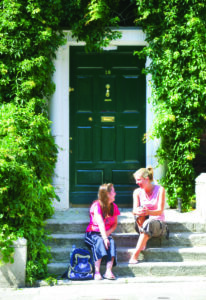 Welcome to Dublin Airport, where after picking up your car you will travel into Dublin and check into your Castle.
Welcome to Dublin Airport, where after picking up your car you will travel into Dublin and check into your Castle.
The remainder of the day can be spent exploring this vibrant and historic capital city with its many historic buildings, Georgian streets and colorful gardens.
Dublin Museum & St. Patrick’s Cathedral
Today why not spend the day exploring some of Dublin’s fine Museums and Galleries? Trace its history from early Viking origins, through to the medieval magnificence of St. Patrick’s Cathedral.
Christchurch Cathedral
Visit Dublinia at Christchurch, which brings the turbulent History of medieval Dublin vividly to life, Visit 16th Century Trinity College, founded by Elizabeth the First, and now home to the famous illuminated manuscript, the Book of Kells.
Guinness Storehouse
Don’t forget about the Guinness Storehouse for a tasting of this world famous ‘black stuff’.
Clontarf Castle
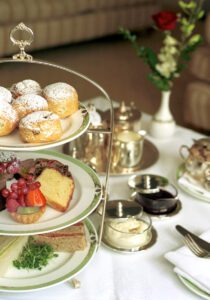 Your first night is spent in Clontarf Castle, which can be dated back to 1172.
Your first night is spent in Clontarf Castle, which can be dated back to 1172.
The current Castle dates back to 1837, but there was a previous Castle on the site in 1172. Hugh de Lacy was the builder of this home to the Knights Templar; famous for fighting in the Crusades. The Castle passed to the Knights Hospitaller in 1308 and then to Viscount Clontarf; who in turn surrendered the Castle to the King.
Belvedere House, Gardens & Park
Leave Dublin this morning and travel across the rich midland pastures. Why not visit Belvedere House, Gardens and Park. The magnificent early 18th century stately home of Robert Rochfort, Earl of Belvedere, stands in 160 acres of parkland on the shores of Lough Ennell.
Belvedere is one of the finest of Ireland’s historic houses, and together with gardens and park has been exquisitely restored. Before you cross the River Shannon, Ireland’s longest river, you can visit Clonmacnoise a 6th century Christian site.
Spanish Arch
Arrive into Galway, which has long traded with Spain and the Spanish influences in the city are many. Of note is Spanish Arch, a gateway in the old city walls and the Spanish Parade, where wealthy merchants and their families enjoyed a stroll along the promenade.
Connemara
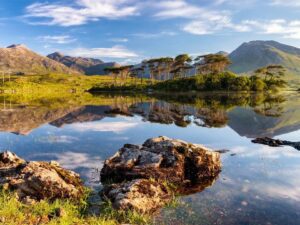 Continue out into the wild and rugged Connemara region, famous for the savage beauty of its lake and mountain scenery and on to Clifden where you shall be staying in the wonderful Abbeyglen Castle which has a panoramic view of Clifden and the bay with a backdrop of the Twelve Bens.
Continue out into the wild and rugged Connemara region, famous for the savage beauty of its lake and mountain scenery and on to Clifden where you shall be staying in the wonderful Abbeyglen Castle which has a panoramic view of Clifden and the bay with a backdrop of the Twelve Bens.
You will travel through the wild and rugged Connemara region, famous for the savage beauty of its lake and mountain scenery. Visit the Connemara National Park, where Connemara ponies and Irish red deer roam freely through 5,000 acres of scenic mountains, bogs and grassland.
Kylemore Abbey
You can also visit the magnificent Kylemore Abbey – a beautiful mansion in a lakeside setting against a mountainous backdrop.
Irish Benedictine nuns, with a tradition of over 300 years, run this unique Abbey set in the midst of Connemara, overlooking Pollacapul Lake.
The Castle was built in the late 1800s by Mitchell Henry MP, inspired by his love for his wife Margaret.
You can make a wish at the Giants Ironing Stone, meet the resident Connemara Ponies and enjoy wholesome food and home-baked goods in the Café or Garden Tea House. Please note: Lunch is not included in tour price.
You may wish to sit in on one of the History talks that take place in the Abbey three times a day, or enjoy a tour of the Welled Garden.
You wont want to miss a browse through the Craft and Design Shop for unique gifts including Kylemore Abbey Pottery, award-winning chocolates handmade by the Benedictine Nuns, Kylemore Abbey Luxury Caramel Sauce and Kylemore Jams handmade onsite in their Chocolate Kitchen!
The beautiful neo-Gothic Church is a short walk from the Abbey, nestled nearby is the Mausoleum where Mitchell and Margaret Henry are buried side by side.
Killary Fjord
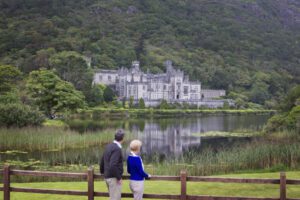 On your return, you can take a scenic drive through Leenane where you have an option to board the Sea Cruise through Killary Fjord which will reveal some of the many hidden Coastal and Mountain Scenery of Connemara. A land of small villages where Gaelic is still the spoken language and where little has changed since the beginning of time.
On your return, you can take a scenic drive through Leenane where you have an option to board the Sea Cruise through Killary Fjord which will reveal some of the many hidden Coastal and Mountain Scenery of Connemara. A land of small villages where Gaelic is still the spoken language and where little has changed since the beginning of time.
Another night will be spent in Abbeyglen Castle.
County Clare – Land of Castles
Leave Clifden this morning, and travel south through Galway and into Clare, known as the “land of castles”. Why not visit Rathbaun Farm and see the animals being tended, or enjoy a traditional tea and scones break?
The Burren
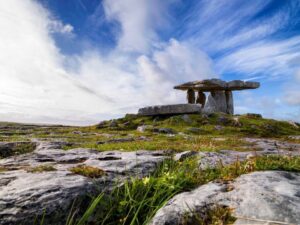 Travel on through the strange lunar landscape of the Burren region , Amaze at the 5,800 year old Poulnabrone Dolmen, the numerous ancient monuments including the Gleninsheen Wedge Tomb and the Ballyalban Fairy Fort – home of the little men with green hats and orange beards!
Travel on through the strange lunar landscape of the Burren region , Amaze at the 5,800 year old Poulnabrone Dolmen, the numerous ancient monuments including the Gleninsheen Wedge Tomb and the Ballyalban Fairy Fort – home of the little men with green hats and orange beards!
The Cliffs of Moher
Visit the Cliffs of Moher a spectacular 5-mile long cliff, which rises almost 200m above sea level.
Stop in the heritage town of Kilrush, before boarding a ferry to Tarbert in north County Ferry (ferry cost not included). Arriving in Tarbert and continue through Listowel and on to Tralee to Ballyseede Castle for overnight
Dingle Peninsula
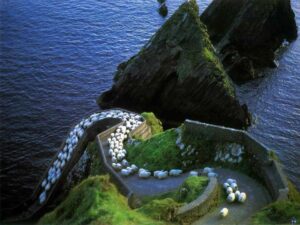 When you travel the Dingle Peninsula, breathtaking landscapes will unfold in front of your eyes as you drive around the Dingle Peninsula where the steep sea-cliffs such as Slea Head allow magnificent views in addition to award winning sandy beaches such as Inch Beach in the south and the tombolo of Maharees to the north which runs over 3 miles long.
When you travel the Dingle Peninsula, breathtaking landscapes will unfold in front of your eyes as you drive around the Dingle Peninsula where the steep sea-cliffs such as Slea Head allow magnificent views in addition to award winning sandy beaches such as Inch Beach in the south and the tombolo of Maharees to the north which runs over 3 miles long.
To the north of the Maharees lie the Magharee Islands or “Seven Hogs:, the largest of which, Oileán t-Seanaigh/Illauntannig, contains remnants of an early Christian monastic settlement, said to have been founded by St. Senan in the 7th century AD.
The Dingle Peninsula or Corca Dhuibhne, stretches 30 miles into the Atlantic Ocean on the south west coast of Ireland’s Wild Atlantic Way. The Peninsula is dominated by the range of mountains that form its spine, spanning from the Stieve Mish range to the Conor Pass and Mount Brandon, Ireland’s second highest peak.
The area is scattered with ancient huts and historic buildings such as the Kilmalkeadar Church. Kilmalkedar was a very important monastery in the early medieval period. The ruined 12th-century Romanesque church displays fine carving, especially on the doorway and on the chancel arch. It became the parish church for the area in the 13th century, and was in use until the 16th century.
Considered by many to have some of Europe’s most spectacular scenery, the peninsula also supports both a rare and unique assortment of flora and fauna.
Slea Head
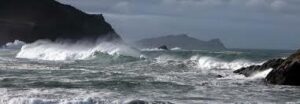 Slea Head, a part of the Wild Atlantic Way, is the most westerly point in Europe. Slea Head is located in the barony of Corca Dhuibhne and standing there, looking towards America, instils a feeling of excitement and empathy with the millions of emigrants who took this route.
Slea Head, a part of the Wild Atlantic Way, is the most westerly point in Europe. Slea Head is located in the barony of Corca Dhuibhne and standing there, looking towards America, instils a feeling of excitement and empathy with the millions of emigrants who took this route.
There are splendid views around Slea Head, especially of the Blasket Islands and the scattered rocks which are all part of an exploded volcanic area.
Blasket Islands
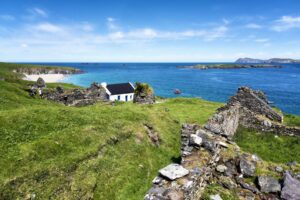 On the westernmost tip of the peninsula, you can visit the Blasket Islands Heritage Centre.
On the westernmost tip of the peninsula, you can visit the Blasket Islands Heritage Centre.
This living history museum explores the dimensions of island-living, from the land, the sea, and the language, to the weather and the seasons, as well as the distinctive character of the Blasket Islanders.
Weather permitting you can embark on a 2 to 3 hour boat trip around the nine main Basket Islands. The islands are remote, unspoiled, unpolluted and spectacularly beautiful and are home to an incredible number of breeding seabirds, with the surrounding seas home to dolphins, porpoises, Atlantic seals and even the occasional whale or orca. (Cost of Boat Trip not included in price of tour)
Medieval Limerick
Spend some time in the medieval city of Limerick, either exploring its history and architecture or purchasing some of the splendid crafts on offer. Why not visit the Hunt Museum, an exhibit of one of Ireland’s greatest private collections of art and antiquities. Leave Limerick and travel eastwards towards Straffan in Co. Kildare.
The Rock of Cashel

Rock of Cashel, Tipperary
En-route a small detour will bring you to the imposing Rock of Cashel which rises dramatically from the flat countryside.
This site has the best set of varied monuments in any Irish site. The rock is crowned by a group of buildings, both ecclesiastical and royal. This multi-period monastic site includes a round tower, a 13th century Romanesque chapel, a high cross, Cormack’s Chapel, consecrated in 1134, with one of Ireland’s best preserved Irish frescoes and Romanesque architecture and the beautifully restored Hall of the Vicar Choral.
The Hall of the Vicars Choral was built in the 15th century. The Vicars Choral were laymen, sometimes minor canons, appointed to assist in chanting the cathedral services. At Cashel there were originally eight Vicars Choral with their own seal.
Barberstown Castle
Continue through rich pastures of Ireland’s midlands where you will arrive in Kildare for your final overnight at Barberstown Castle, a 13th century castle, located in the heart of the horse-breeding county of Kildare.

